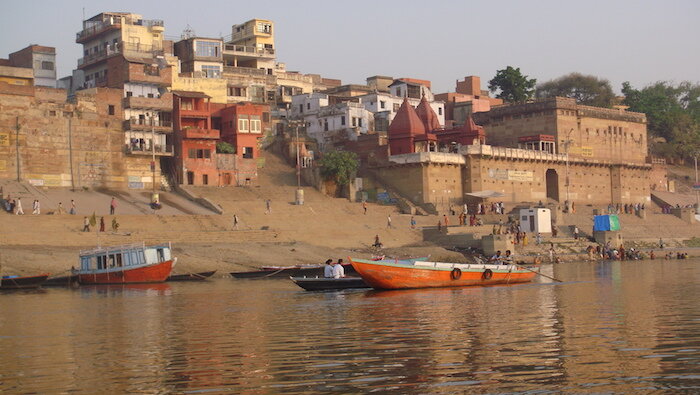Market in Jaipur, India
A Personal Sensory Experience of India
Travel through India isn't travel through India without blaring horns, cockroaches, saturated olfactory cells and sweat. The polarity of India both in experience and smell are difficult to process. When travelling there, I consistently found myself simultaneously tearing up and warm of heart. A girl begs while a flower merchant smiles. A young boy serves masala chai while vultures feed on a corpse. I ogle at market trinkets while a Mahila branded by acid burn passes by. Graffiti reads Namaste on a residence that houses gender-based discrimination. Few places in the world rival India in its sensory overload particularly smells and sound. These two only rivalled by colour in the land of Bharat. At times the odours play games with your mind at other times they form a template filled in by sight and sound and tactile elements. The smells can be as assaulting as the heat and the smog. But they also mosaic your Indian adventure. It wouldn’t be an Indian adventure without it, particularly in the Golden Triangle: Delhi, Agra, Jaipur.
I’ve heard Indians are very patriotic of their smell palate. It’s undoubtedly unique. Masala chai, incense, mange, camphor flames, spices, fried foods, cow dung, blooms. The odours are comparable to the aesthetic of the region. A direct depiction of the disparity, turbulence and sentiment of India. The land of contrasts: Bright colours and taupe, fiercely religious and farcical, enveloping kindness and visceral cruelty. It was in this land that for the first and only time I acutely experienced the smell of acrid, but also unparalleled spice blends. The smells of India conjures feelings you’ve never experienced before that have no terms to describe them. For the natives of India, I’m sure it’s all based on nostalgia.
Vegetable merchant in India
If Countries Exhibited Synesthesia
If a country exhibited synesthesia, it would be most definitely be India. Colours and smells melding with experiences and linguistics. The sound and smellscape of India is perhaps a reflection of the serene and chaotic emotion felt by the land. There exists desperation, dogged beliefs, grotesque growths, marigold, saffron and cumin. Fruit offerings and sacred cow dung, dusty bougainvillaea, hot milk and fry off. You would assume that the waters of the Ganges would douse the multi-dimensional tapestry of odours. But in fact, it seems to augment the assault on the nostrils. Perhaps it’s all those microbes in the water. For Indians who bathe in the Ganges each day, it’s a sacramental practice that builds immunity. For tourists the Burning Ghats of Varanasi, the floating carcases in amongst the floral wreaths, trinkets and offerings can bring on queasy.
Heart-breaking and raw: Indian girl begging
Smellscapes
Urban environments have been lauded for many things—namely their diverse sights, sounds, flavours, and interesting people—but scents usually don’t register on the list of attractions. The world of urban “smellscapes” has opened up to us a perspective of appreciating and recognising, all odours and their corresponding associations.
The term smellscape, which was first coined in 1990 by geographer J. Douglas Porteous (in his book Landscapes of the Mind: Worlds of Sense and Metaphor), is used to describe the “smell environment” of a given place (both its individual component odours and its overarching scent). If you have ever been to, for example, a small coastal British town or city, you can likely recall the pungent odour of fresh fish and chips wafting out from countless shops, the salty tang of the sea air, the mossy, slightly moldy scent of perpetually damp buildings and trees, and the misty kiss of gentle rain on pavement.
Sensory Mapping
Smell is one of our most evocative senses, and it is most closely tied to memory and nostalgia. Graphic designer and photographer Kate McLean, the world's current leading “smellscape mapper”, explains why this is so relevant, particularly for travellers who wish to hold onto the precious memories of their many journeys:
“Smell has a 'do not enter, brain processing' connection with our emotions, making smell the supreme retainer of memory over our other senses,” Kate explains. “We have 100 per cent smell recall after one year but only 30 per cent sight memory after three months.”
To aid in this endeavour, Kate works in creating smellscape maps of various cities documented on her site Sensory Maps, based both on her impressions and countless interviews with local people regarding what they smell in the environments around them. The maps display colour-coded areas depicting the margins (and overlaps) of various smells within a given city. The site now offers taste and tactile maps as well.
The smellscape phenomenon as part of tourism appears to be catching on, to the point where interested parties today use smell maps to help devise specialised “smell walks” around cities with particularly diverse and delightful scents.
While sensory tourism remains in its relative infancy, a handful of cities around the globe have already been pinpointed as having particularly rich scent environments. Paris, perhaps unsurprisingly, tops most people's lists, with its many outdoor cafes, it’s bakeries, cut flowers, and perfumed citizens. Scotland's Edinburgh has the unique attraction of being one of relatively few major European cities to still be dominated by the smell of a brewery, and Amsterdam likewise gets a favourable mention owing to the rich odour of flowers that permeates it at certain times of the year. It doesn’t appear as though India makes an appearance on the sensory map list, but that’s okay, we can create our own. Clearly, it will be nowhere near as sophisticated as the sensory maps compiled by Kate.
You don't have to travel to one of these bustling destinations to begin enjoying the world of urban scents and sensory mapping. Simply seeking to tune into the smells of your surrounding environment and taking note of each one can prove to be a fascinating, immersive experience.
The Ganges of Varanasi, India








